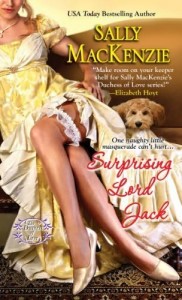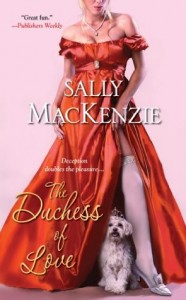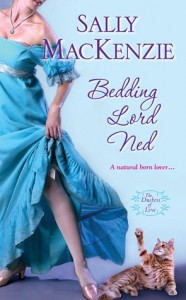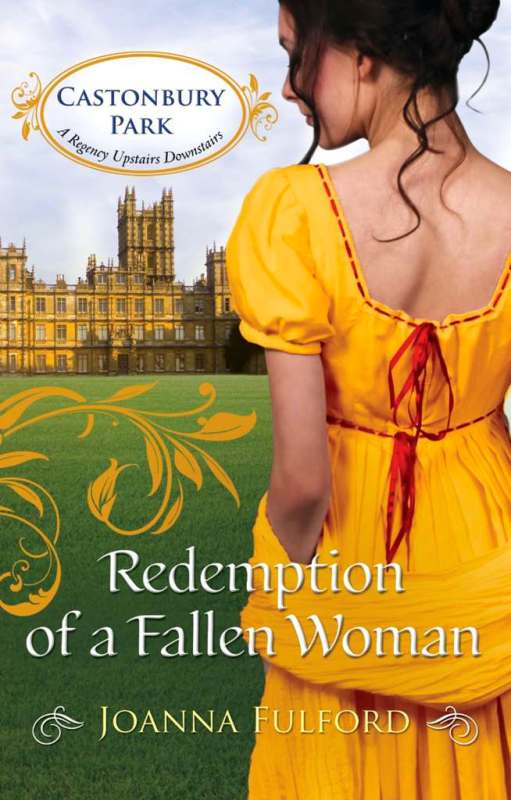 Diane here.
Diane here.
Today we welcome back Sally MacKenzie to talk about her latest Regency, Surprising Lord Jack. Sally just keeps giving us charming books. First the Naked series, now the Duchess of Love series. By giving, I also mean Sally is giving away a signed copy of Surprising Lord Jack to one lucky commenter chosen at random.
 Here is what reviewers are saying about Surprising Lord Jack
Here is what reviewers are saying about Surprising Lord Jack
*Starred review* “MacKenzie has penned another humorous Regency-era gem that will get a collective thumbs-up from readers.”–Shelley Mosley, Booklist
Four stars. “MacKenzie delights her devoted fans once again with a quick-witted, steamy romp. Add a touch of mystery and another bright tale of love and laughter is born. An engaging, and meddlesome, cast whips this lusty tale into a perfect heart-holiday treat!”–Anne Black, RT Book Reviews
4.50 / 5 -Reviewer Top Pick. “I recommend this book to all my fellow historical romance fans.”–Debra Taylor, Night Owl Reviews
Welcome back, Sally!
Hello, Riskies! I’m so glad to be stopping by again. I had a chance to see Diane at the Washington Loves Romance gathering in February. She was apparently deep in deadline craziness, but she looked calm and composed as always– (Diane note: Most likely I was merely sleep-deprived…)
Tell us about Surprising Lord Jack.
Surprising Lord Jack is the second book in my Duchess of Love trilogy. (Well, it’s a trilogy plus a novella: “The Duchess of Love” is the prequel to the series and tells how the duchess met her duke.) It’s about the duchess’s youngest son, and it begins where Bedding Lord Ned, the first book in the series, ends.
Here’s the back cover copy:
Unladylike behavior…
Frances Hadley has managed her family’s estate for years. So why can’t she request her own dowry? She’ll have to go to London herself and knock some sense into the men interfering in her life. With the nonsense she’s dealt with lately, though, there’s no way she’s going as a woman. A pair of breeches and a quick chop of her red curls, and she’ll have much less to worry about…
Jack Valentine, third son of the famous Duchess of Love, is through being pursued by pushy young ladies. One particularly determined miss has run him out of his own house party. Luckily the inn has one bed left. Jack just has to share with a rather entertaining red-headed youth. Perhaps the two of them should ride to London together. It will make a pleasant escape from his mother’s matchmaking melodrama!
There a Jack the Ripper sort of plot thread as well: someone is slitting the throats of prostitutes and even society women with soiled reputations, a class into which Frances now falls.
I’m excited because ALA Booklist gave Jack a starred review!
What is risky about the book?
Well, three things come to mind, though they might be more tricky than risky.
First, I wanted to try my hand at a “chick-in-pants” book, where the heroine pretends to be a man–or, in this case, a boy. Sometimes in these stories, the hero begins to fall in love with the heroine even before he knows her true gender. However, I happened to be working on Jack’s book during the Jerry Sandusky scandal. I followed the news reports pretty closely, partly because I have sons who’ve competed in Division I varsity athletics (and I went to the University of Notre Dame), so I’m interested in the whole question of the power athletics has in a college’s culture. But mostly, of course, I was reading and listening to news reports because the story was so horrifying. And since I’m the mother of boys, these kinds of events make me start questioning my sons to see if any coach or scout leader or other male in their lives ever did anything inappropriate with them. (My questioning drives them crazy, by the way. None of the men I’m related to wanted to discuss the trial.)
So with that, there was no way I was going to have Jack feel any sexual attraction for Frances while she was pretending to be male. Frances, however, was free to fall in love with Jack, except she hates men. So making their relationship develop when she’s in disguise was tricky.
 Second, Jack’s book is the middle of a trilogy, and, unlike the Naked series, I planned these books to fit together. The first book had the advantage of setting things up, and the last book gets to tie things together (I hope). But the middle book is, well, in the middle. It’s got the threads I planned to run through the series coming and going. It has to be able to handle that, but be a satisfying, complete story on its own. So it was a bit tricky keeping things balanced. I think I managed it, though. A reviewer who’s read only Jack’s book told me she didn’t feel the need to have read Ned’s story first, so that was a big relief!
Second, Jack’s book is the middle of a trilogy, and, unlike the Naked series, I planned these books to fit together. The first book had the advantage of setting things up, and the last book gets to tie things together (I hope). But the middle book is, well, in the middle. It’s got the threads I planned to run through the series coming and going. It has to be able to handle that, but be a satisfying, complete story on its own. So it was a bit tricky keeping things balanced. I think I managed it, though. A reviewer who’s read only Jack’s book told me she didn’t feel the need to have read Ned’s story first, so that was a big relief!
 Third, the books are set in a pretty tight timeframe. Jack’s book actually begins as Ned’s is ending. I haven’t tried that before.
Third, the books are set in a pretty tight timeframe. Jack’s book actually begins as Ned’s is ending. I haven’t tried that before.
Was it easy to write?
Argh!! No. Maybe because it was the middle book, it just about killed me. I finished the first draft and revised and polished, but the book wasn’t working. I had to do pretty much a complete rewrite–or at least it felt that way. And since my publisher had moved the release date up, I had a real honest-to-God, drop dead deadline. The icing on the cake was that the D.C. derecho roared through a few days before that deadline, leaving our house intact, thank God, but taking our electricity and internet. I had to write with an eye on my laptop battery’s charge indicator and be creative in finding places to recharge when it got low. I discovered the church’s “crying room” had an outlet that worked, so I sat through Sunday Mass plugged in. (No, I wasn’t working, and no, there weren’t any babies in the room with me at the time, and yes, I felt very good about going to church that week.) When we went out to eat, I asked for a table with an outlet. The upside was that I kept my nose to the grindstone–no internet to distract and no battery power to waste on endless games of computer solitaire. When I was done–the day I had to send the manuscript off–I went to Panera’s to use their internet.
Did you come across any interesting research?
Yes–and Janet has already told you all about it. Back on November 15, Janet posted about the Threads of Feeling exhibit*. I was so excited! No, I didn’t know about the exhibit (until Janet mentioned it), but I had been researching London’s Foundling Hospital, so I knew mothers used to leave scraps of fabric when they gave up their babies, sort of like a claims check, I guess…so they could come back and reclaim their children once they were able to care for them.
I knew Jack was going to have some sort of charity he was involved in, and it made sense to me that since Ned’s son died in childbirth, the charity would have something to do with children. Well Jack actually has two charities–one for prostitutes who want a way out of that life and one for abandoned children. I researched the Foundling Hospital to see if such a plan would work, though the children at Jack’s house are mostly the offspring of prostitutes, abandoned on the streets. He finds them, brings them to his “foundling hospital,” and educates them until they are old enough to find work.
Bedding Lord Ned had a thieving cat. There’s a dog on Surprising Lord Jack’s cover. Does he have a role in the story?
Of course! The dog’s name is Shakespeare; Jack and Frances discover him with an abandoned baby in the stews, and he can do all kinds of tricks.
I may have said before that I’m a bit of a pantser–the story develops as I write it. I realized that Shakespeare had belonged to a local actor who’d decamped for parts unknown, leaving his dog behind. I thought that was a bit odd, and I filed it away as a “possibly important but currently mystifying” detail. At the end of the story, I discovered that Shakespeare’s former owner had a role to play in resolving the Jack the Ripper thread.
And I’m sure any dedicated plotters reading this are now twitching.
I never thought I would be a pantser. If you ask any of my four sons, I’m sure they’d say I’m a control freak. I think I scored “possible army officer” on the career test I took in college. But, to quote Popeye, “I yam what I yam.”
What’s next for you?
I’ve finished the first draft of Loving Lord Ash, the last book in the trilogy which should be out in Spring 2014. Maybe because I’m a pantser, I can’t just type “the end” and send a manuscript off to my editor, though. I usually take several weeks to a month to revise and polish before I’m willing to part with a story. I’m just hoping Ash doesn’t give me the fits Jack did!
And now a question for your readers: Do you have a favorite book that features a cross-dressing heroine? Mine is Fool’s Masquerade by Joan Wolf. I have to say I’m a big fan of Joan Wolf’s Regencies–I have many of them on my keeper shelf. (Okay, really a keeper box.) Why do you like this kind of story–or if you don’t like “chick-in-pants” books, why not?
Thanks for being our guest, Sally. Readers, do not forget to comment for a chance to win Surprising Lord Jack.
*The Threads of Feeling exhibit comes to Williamsburg, VA, May 25, 2013.










